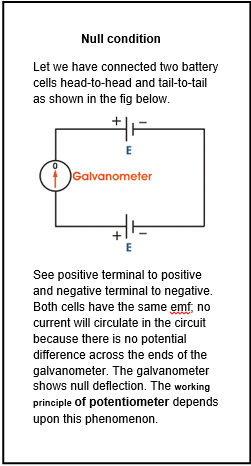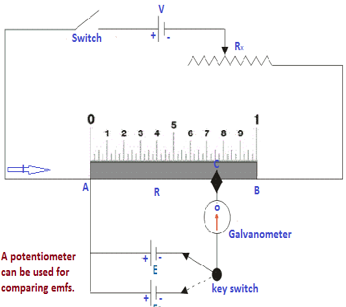Question 7: What is potentiometer? Explain the principle, construction and working. What is the advantage of using potentiometer for measuring potential difference?
ANSWER
Potentiometer

A potentiometer is a null type resistance network device used for measuring potential differences and comparison of emfs of potential difference sources.
Principle
A potentiometer works on the principle of balancing one voltage against another in parallel with it.
Construction and working of potentiometer
It consists of a long resistance wire AB, sometimes 6 m in length, and of uniform diameter. This resistance wire R, a working battery and a variable resistance Rx all connected in series. Rx enables us to develop a convenient output voltage V between A and B, maintaining a constant current I in the circuit. Now, according to Ohm’s law I = V/R

A source of emf ε which is to be measured is connected along with a Galvanometer through the sliding contact C. See figure. As C slides over AB, a variable potential difference is available between A and C. If r represents the resistance between A and C, the potential drop between A and C is given by

Now if the PD between A and B is greater than ε , then there must be some point C between A and B, at which the potential drop across AC is equal to ε. This point is found by sliding C over AB until the current in the galvanometer is zero. The current in galvanometer becomes zero because under such condition, called null condition, both the ends of the galvanometer are at the same potential. So under null conditions;

Here r is the value of the wire resistance of length AC at null condition.
Let the wire is of uniform cross-section A and AB = L and AC = l, then

(We know that resistance is directly proportional to the length and inversely proportional to the cross-sectional area of the wire.)
Divide one equation by the other

Where L is the total length of the wire and l is the length AC.
Put this value in equation (1), This equation gives the unknown emf in terms of the ratio of two known lengths and voltage applied. Ordinarily, the potential drop along the wire is calibrated and the balanced point gives directly the unknown emf ε
This equation gives the unknown emf in terms of the ratio of two known lengths and voltage applied. Ordinarily, the potential drop along the wire is calibrated and the balanced point gives directly the unknown emf ε
Comparison of emfs

Potentiometer can also be used for the comparison of two emf sources. The balancing length of emf ε1of a cell is found and compared with the balancing length of a standard cell which is also found separately. If ε and ε1 are the two emf sources nulled at lengths l and l1 respectively, then,

Dividing one equation by other,

Applications of potentiometer
- Ammeters and voltmeters are calibrated with the help of potentiometer.
- Comparing emfs of two cells.
- Measurements of current and resistance.
- Measurements of small and high emfs.
Advantages:
1. The errors due to line drop don’t occur as at null condition, the potentiometer draws no current from the source of emf to be tested.
2. The actual emf is obtained and not the terminal potential difference.

Pingback:thermocouple-thermoelectric-emf – msa
Pingback:index-cqs-ch13-p12 – msa